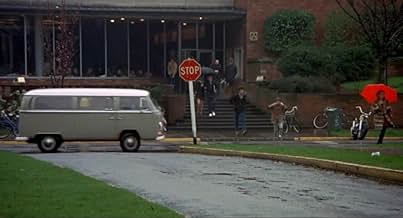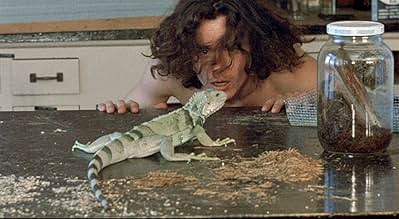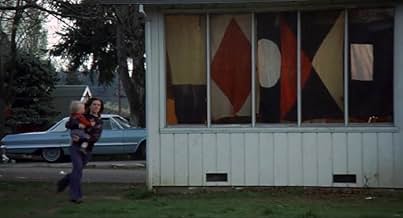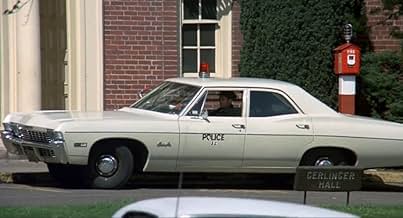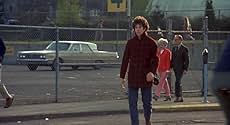CALIFICACIÓN DE IMDb
5.7/10
1.9 k
TU CALIFICACIÓN
La vida de una estrella del baloncesto universitario se complica por un romance prohibido mientras su compañero enloquece evadiendo el servicio militar.La vida de una estrella del baloncesto universitario se complica por un romance prohibido mientras su compañero enloquece evadiendo el servicio militar.La vida de una estrella del baloncesto universitario se complica por un romance prohibido mientras su compañero enloquece evadiendo el servicio militar.
- Dirección
- Guionistas
- Elenco
- Premios
- 1 premio ganado y 1 nominación en total
Michael Warren
- Easly
- (as Mike Warren)
Lynette Bernay
- Dance Instructor
- (as Lynn Bernay)
Joseph Walsh
- Announcer #1
- (as Joey Walsh)
David Ogden Stiers
- Pro Owner
- (as David Stiers)
Mireille Machu
- Secretary
- (as I.J. Jefferson)
Opiniones destacadas
10titov
This may be the only film that actually comes close to capturing on film the essentially uncapturable world of the American college experience of the late 60s-early 70s. Go ahead, name another movie that even approaches this one: "Getting Straight"? "RPM"? These are caricatures. "Return of the Secaucus Seven" has its moments, but that's a retrospective film about (self-obsessed) individuals more than a film about a time and a place depicted *in* that time and place. "Drive, He Said" portrays-- with subtlety and nuance where it should, and a swift kick in the shorts where that's the only appropriate way-- the anti-draft movement, the ambiguity of big-time college sports (especially when there's a war on), the sexual revolution of the period, and the general unreality of the day. Believe me, it was like that.
The whole cast deserves commendation (as does the director, of course) but particular praise should be reserved for Bruce Dern, as the basketball coach, and Karen Black, the hero's very unusual-- except for that time-- love interest. William Tepper, as the lead, also rates a real round of applause both for his perfect capturing of the student-athlete of the period and for actually playing real college basketball in the film (remember Anthony Perkins in "Tall Story"? Yikes!).
All in all, a classic of a kind-- and the last film someone currently in 6th grade should be writing comments on ("boring", "repellent"-- um, right, sonny, please go back to your Arnold movies). Why isn't this film available from imdb?
The whole cast deserves commendation (as does the director, of course) but particular praise should be reserved for Bruce Dern, as the basketball coach, and Karen Black, the hero's very unusual-- except for that time-- love interest. William Tepper, as the lead, also rates a real round of applause both for his perfect capturing of the student-athlete of the period and for actually playing real college basketball in the film (remember Anthony Perkins in "Tall Story"? Yikes!).
All in all, a classic of a kind-- and the last film someone currently in 6th grade should be writing comments on ("boring", "repellent"-- um, right, sonny, please go back to your Arnold movies). Why isn't this film available from imdb?
Not much to make of this directorial debut by would-be star actor and frequent attendee of Los Angeles Lakers games Jack Nicholson, "Drive, He Said," which doesn't so much get its title from the basketball played in the film as it does from a poem, "I Know a Man," by Robert Creeley, which is recited at the beginning as the college hoops game is broadcast on a TV in the background. Soon thereafter, the poem-reciting, counterculture youths dressed in camouflage paramilitary regalia invade the gymnasium of the game to put on a bit of performance art that's as vaguely against, or agitated by, rather, American militarism--specifically the Vietnam War--as is the rest of the picture. Seems the war is such a weight on these young men's minds that it drives one to insanity and another to waffle over whether he wants to really play basketball or not.
Neither character arc is very compelling, and the crazy one is over-the-top ridiculous. There are easier ways to avoid a draft, guys, whether it's for the NBA or USA. And poor Karen Black having to put up with this tomfoolery and, worse, replaying an attempted-rape climax as old as D. W. Griffith silent films and the Victorian literature he in turn stole it from. The entire film is as muddled as its basketball footage with barely a narrative to be found, and it's undoubtedly dated as an independent film from the early '70s.
On the other hand, there's enough here, to use a cliché from another sport, out of left field to be at least bemusing. Plus, at least the actors evidently know how to dribble and shoot enough to keep up with apparent real former collegiate athletes. The Leopards team's mascot is a real, caged leopard that occupies the sidelines. A lot here concerning caged animals and letting them loose, which is the sort of motif that goes for symbolism in this picture. At one point, a montage of slow-motion basketball footage is played to "The Star-Spangled Banner." As the making-of-video included on the Criterion disc claims, it also includes some guerilla filmmaking exploiting a real riot that broke out during filming at the University of Oregon, which fits seamlessly within the rest of the picture's aesthetics. The remainder of the movie mostly seems to merely revel in the Sexual Revolution, including a considerable amount of focus on male genitalia. Nicholson claims he wanted a "symphony of dicks" during a locker-room shower scene, which supposedly he had to compromise on, but not by much.
Neither character arc is very compelling, and the crazy one is over-the-top ridiculous. There are easier ways to avoid a draft, guys, whether it's for the NBA or USA. And poor Karen Black having to put up with this tomfoolery and, worse, replaying an attempted-rape climax as old as D. W. Griffith silent films and the Victorian literature he in turn stole it from. The entire film is as muddled as its basketball footage with barely a narrative to be found, and it's undoubtedly dated as an independent film from the early '70s.
On the other hand, there's enough here, to use a cliché from another sport, out of left field to be at least bemusing. Plus, at least the actors evidently know how to dribble and shoot enough to keep up with apparent real former collegiate athletes. The Leopards team's mascot is a real, caged leopard that occupies the sidelines. A lot here concerning caged animals and letting them loose, which is the sort of motif that goes for symbolism in this picture. At one point, a montage of slow-motion basketball footage is played to "The Star-Spangled Banner." As the making-of-video included on the Criterion disc claims, it also includes some guerilla filmmaking exploiting a real riot that broke out during filming at the University of Oregon, which fits seamlessly within the rest of the picture's aesthetics. The remainder of the movie mostly seems to merely revel in the Sexual Revolution, including a considerable amount of focus on male genitalia. Nicholson claims he wanted a "symphony of dicks" during a locker-room shower scene, which supposedly he had to compromise on, but not by much.
This was a very interesting movie, as it was Jack Nicholson's directorial debut, and included several other stars before they "became big" such as Bruce Dern and Karen Black. I was an extra in this movie when filmed on the University of Oregon campus/in Eugene area in 1971. Before it came out in theaters, I had left the country for the Peace Corps. When I returned, it had come and gone but I never got a chance to see it.
I remember one of the scenes was filmed with a camera inside a basket ball, and was passed back and forth across the court running from one end to the other to "get a perspective from the ball's viewpoint".
Anyone seen any copies (vhs or other options for getting a copy)? Would love to see it, as I was in several scenes but again never saw it.
Thanks for any leads or ideas of where one would go to get more info.
Bob Petow (bobpetow@comcast.net)
I remember one of the scenes was filmed with a camera inside a basket ball, and was passed back and forth across the court running from one end to the other to "get a perspective from the ball's viewpoint".
Anyone seen any copies (vhs or other options for getting a copy)? Would love to see it, as I was in several scenes but again never saw it.
Thanks for any leads or ideas of where one would go to get more info.
Bob Petow (bobpetow@comcast.net)
Drive, He Said (1971)
** (out of 4)
Jack Nicholson's directorial debut is a confussing mess but here goes. The film deals with a troubled basketball star (William Tepper) who's caught in an affair with a teacher's wife (Karen Black). The only person trying to make him go straight is his coach (Bruce Dern) but outsiders keep stepping in the way. The film was also co-written by Nicholson and most of the blame can start right here. The film is all over the place and it seems there are enough story lines for at least five other movies. There's also a subplot with a friend who's trying to dodge the draft, which goes no where and leads to some pretty over the top, wannabe serious moments. The one thing going for the film are some pretty good performances, although it appears Dern is trying to give a Nicholson impersonation. Nicholson's direction hits a few good notes but in the end this seems like something that would have only been shown on TV. Needless to say it's never gotten an official release on home video.
** (out of 4)
Jack Nicholson's directorial debut is a confussing mess but here goes. The film deals with a troubled basketball star (William Tepper) who's caught in an affair with a teacher's wife (Karen Black). The only person trying to make him go straight is his coach (Bruce Dern) but outsiders keep stepping in the way. The film was also co-written by Nicholson and most of the blame can start right here. The film is all over the place and it seems there are enough story lines for at least five other movies. There's also a subplot with a friend who's trying to dodge the draft, which goes no where and leads to some pretty over the top, wannabe serious moments. The one thing going for the film are some pretty good performances, although it appears Dern is trying to give a Nicholson impersonation. Nicholson's direction hits a few good notes but in the end this seems like something that would have only been shown on TV. Needless to say it's never gotten an official release on home video.
Poorly developed and fragmented movie about a confused college basketball player with a host of predictably militant and/or cynically unhappy acquaintances characteristic of 1960s academia where the film is set. I'm not sure whether we are supposed to like or even care about the characters or not, but in any event I didn't feel much of either for any of them. Jack Nicholson directed this movie with a taste for profanity and nudity. I guess he thought he was being provocative and progressively mirroring the changing cultural mores of the time. He would have fared better by putting his energy into developing characterization and refining the script that he co-wrote instead. All in all a disappointing movie which left me with a feeling of indifference about it.
¿Sabías que…?
- TriviaJack Nicholson's solo directorial debut. It was one of two post-Easy Rider (1969) Nicholson films that weren't released on any kind of home video until 2010. That year, the Criterion Collection released this movie and A Safe Place (1971) on DVD and Blu-ray as part of their "America Lost And Found - The BBS Story" box set.
- ErroresDuring the second basketball game, the writing on the Ohio Leopards jerseys frequently changes from "Leopards" to "Ohio" on a shot by shot basis.
- Créditos curiososThe opening credits are typed so small, one can hardly read them. Sometimes the letters in the names are blurred because of their ultra-small size.
- ConexionesFeatured in Skin: A History of Nudity in the Movies (2020)
Selecciones populares
Inicia sesión para calificar y agrega a la lista de videos para obtener recomendaciones personalizadas
- How long is Drive, He Said?Con tecnología de Alexa
Detalles
Taquilla
- Presupuesto
- USD 800,000 (estimado)
Contribuir a esta página
Sugiere una edición o agrega el contenido que falta


